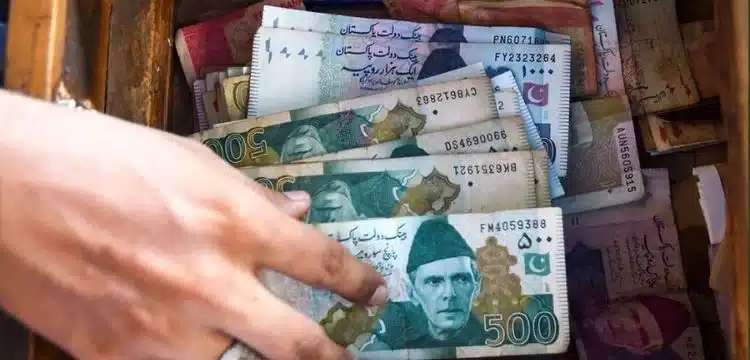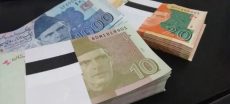[vc_row][vc_column][vc_column_text dp_text_size=”size-4″]
The Pakistani rupee continued its positive momentum against the US Dollar, marking its eighth consecutive day of gains in the interbank market. The day commenced with the rupee opening trade at 279 against the greenback.
Throughout the intraday trade, the rupee remained relatively stable against the US Dollar, showing minimal fluctuations. At one point, it briefly touched 278 at 12:55 PM but quickly reverted to 279. The interbank rate later stabilized at 279, maintaining this level for the rest of the trading session. Open market rates, observed across various currency counters, also demonstrated stability within the 279 range.
Read more: Rupee Strengthens, Dipping Below 280 Against US Dollar In Interbank
At the close of the trading day, the Pakistani rupee appreciated by 0.03 percent, settling at 279.59 and gaining 7 paisas against the US Dollar.
Building on yesterday’s marginal uptick, the rupee’s positive trend has persisted for the eighth consecutive day. Cumulatively, on a fiscal year-to-date basis, it has appreciated by 2.27 percent.
Despite this recent positive trajectory, it’s important to note that the rupee has witnessed a significant depreciation over a longer time horizon. Since January 2023, it has declined by nearly Rs. 60, and since April 2022, the depreciation stands at over Rs. 107 against the US Dollar. In the context of the present exchange rate movements, the Pakistani rupee gained 7 paisas against the US Dollar on this particular day.
A trader provided insights, indicating that the rupee’s upward movements have slowed since the end of November 2023. There is a possibility of a reversal in the rupee’s gains if any late political developments alter expectations for buyers leading up to the February election. The caretakers’ effective handling of IMF talks has contributed to the positive sentiment in money markets in recent weeks. However, potential uncertainties arising from domestic politics and unexplained interventions at the governance level could impact market sentiments. The trader emphasized the need for the state to avoid unwanted confrontations to prevent a repeat of challenges faced last year. Some argue that elections may not happen, and if they do, the outcomes may not be well-received by certain beneficiaries.
In a significant development, the foreign exchange reserves held by the State Bank of Pakistan (SBP) witnessed an increase of $243 million, reaching $8.27 billion compared to $8.027 billion on January 12. The central bank highlighted that this increase was attributed to the receipt of the second tranche of $705 million from the International Monetary Fund (IMF) under the $3 billion Stand-By Arrangement (SBA) and the execution of the government’s external debt repayments.
In terms of other major currencies, the Pakistani rupee showed strength in the interbank market. It gained one paisa against the Saudi Riyal (SAR), two paisas against the UAE Dirham (AED), Rs. 1.19 against the British Pound (GBP), and Rs. 2.01 against the Euro (EUR). These movements reflect the complex dynamics of currency markets and their sensitivity to various economic and geopolitical factors.
[/vc_column_text][/vc_column][/vc_row]











